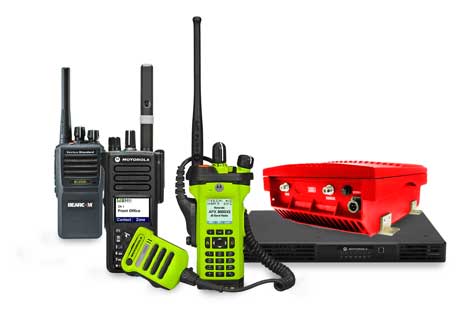One of the biggest challenges of using two-way radios is moving outside of radio range and having your conversation cut off. Radio signals travel in highly specific ways. If you disrupt those principles, then your conversation will fade or end altogether.
To avoid poor coverage and dead zones, you need a way to boost wireless signals. We will review how to extend wireless radio range with Bi-Directional Amplifiers, or BDAs. Read all about it below, and contact BearCom for assistance with your next wireless communications project.
 Depending on the kind of radio you are using, a signal can travel anywhere from a few hundred feet to several miles. Portables typically offer 1 to 5 watts of power, and mobiles offer 25 to 100 watts. In general, the higher the power rating, the greater the signal strength. Since digital radios typically deliver stronger voice clarity than analog models, in many instances digital radios can be further apart and still communicate effectively. For nearly any radio, larger antennas generally extend range.
Radio Frequency
Depending on the kind of radio you are using, a signal can travel anywhere from a few hundred feet to several miles. Portables typically offer 1 to 5 watts of power, and mobiles offer 25 to 100 watts. In general, the higher the power rating, the greater the signal strength. Since digital radios typically deliver stronger voice clarity than analog models, in many instances digital radios can be further apart and still communicate effectively. For nearly any radio, larger antennas generally extend range.
Radio Frequency
Radio Frequency (RF) refers to a wireless electromagnetic signal used for communication. Radio waves are a form of electromagnetic radiation. They identify radio frequencies that range from 3 KHz to 300 GHz. RF communication is used in many industries, including television broadcasting, radar systems, wireless communications, and computer and mobile platform networks. The most common two-way radio bands for commercial and industrial users are UHF (Ultra High Frequency) and VHF (Very High Frequency). Public Safety generally uses bands 450/700/800 MHz. UHF signals operate at the higher end of the radio frequency spectrum. Since UHF more easily penetrates metal and concrete structures, they provide a stronger signal inside buildings, in urban areas, and outdoors in densely wooded or hilly areas. VHF signals occupy the lower end of the radio frequency spectrum, so the wavelengths travel further than UHF. VHF radios don’t penetrate metal and concrete structures very well so are excellent for open structures and relatively flat outdoor environments. Building Materials
Another factor that determines radio range is barriers, such as concrete, metal, and glass. Since radio signals often cannot pass through these materials, the result can be intermittent or complete loss of coverage when going in and out of buildings, or into problem areas. Extending Range
When in-building communication consistently gets cut off because users are too far apart, then you need to extend radio coverage. Repeaters
Most two-way radio users are familiar with repeaters, and in many instances repeaters boost signal enough to sustain in-building coverage. However, in larger and more complex structures, repeaters may not provide adequate signal strength. Fortunately, in these conditions, installing Bi-Directional Amplifiers into the Distributed Antenna infrastructure can help keep the lines of communication open. MOTOROLA, MOTOROLA SOLUTIONS and the Stylized M Logo are trademarks or registered trademarks of Motorola Trademark Holdings, LLC and are used under license. All other trademarks are the property of their respective owners. ©2018 Motorola Solutions, Inc. All rights reserved.
MOTOROLA, MOTOROLA SOLUTIONS and the Stylized M Logo are trademarks or registered trademarks of Motorola Trademark Holdings, LLC and are used under license. All other trademarks are the property of their respective owners. ©2018 Motorola Solutions, Inc. All rights reserved.
Determining Radio Range
There are several factors that influence radio range. Type of Radio Depending on the kind of radio you are using, a signal can travel anywhere from a few hundred feet to several miles. Portables typically offer 1 to 5 watts of power, and mobiles offer 25 to 100 watts. In general, the higher the power rating, the greater the signal strength. Since digital radios typically deliver stronger voice clarity than analog models, in many instances digital radios can be further apart and still communicate effectively. For nearly any radio, larger antennas generally extend range.
Radio Frequency
Depending on the kind of radio you are using, a signal can travel anywhere from a few hundred feet to several miles. Portables typically offer 1 to 5 watts of power, and mobiles offer 25 to 100 watts. In general, the higher the power rating, the greater the signal strength. Since digital radios typically deliver stronger voice clarity than analog models, in many instances digital radios can be further apart and still communicate effectively. For nearly any radio, larger antennas generally extend range.
Radio FrequencyRadio Frequency (RF) refers to a wireless electromagnetic signal used for communication. Radio waves are a form of electromagnetic radiation. They identify radio frequencies that range from 3 KHz to 300 GHz. RF communication is used in many industries, including television broadcasting, radar systems, wireless communications, and computer and mobile platform networks. The most common two-way radio bands for commercial and industrial users are UHF (Ultra High Frequency) and VHF (Very High Frequency). Public Safety generally uses bands 450/700/800 MHz. UHF signals operate at the higher end of the radio frequency spectrum. Since UHF more easily penetrates metal and concrete structures, they provide a stronger signal inside buildings, in urban areas, and outdoors in densely wooded or hilly areas. VHF signals occupy the lower end of the radio frequency spectrum, so the wavelengths travel further than UHF. VHF radios don’t penetrate metal and concrete structures very well so are excellent for open structures and relatively flat outdoor environments. Building Materials
Another factor that determines radio range is barriers, such as concrete, metal, and glass. Since radio signals often cannot pass through these materials, the result can be intermittent or complete loss of coverage when going in and out of buildings, or into problem areas. Extending Range
When in-building communication consistently gets cut off because users are too far apart, then you need to extend radio coverage. Repeaters
Most two-way radio users are familiar with repeaters, and in many instances repeaters boost signal enough to sustain in-building coverage. However, in larger and more complex structures, repeaters may not provide adequate signal strength. Fortunately, in these conditions, installing Bi-Directional Amplifiers into the Distributed Antenna infrastructure can help keep the lines of communication open.
Using BDAs to Extend Radio Range
As part of a Distributed Antenna System, Bi-Directional Amplifiers (BDAs) boost two-radio signals throughout a facility. This includes stairwells, underground tunnels, and parking garages — any area with poor reception. BDAs are an excellent way to improve productivity and safety in day-to-day operations by connecting staff and keeping remote workers in-touch with other team members. These signal boosters are also great tools for first responders, so they can stay in constant contact throughout a building in an emergency situation. In fact, many localities require BDAs for Public Safety communications.Steps to Extend Wireless Radio Range
Deploying signal boosters for your communications system is one of the best ways to improve wireless radio (and cellular device) range. A booster system has three parts:- A small donor antenna mounted on the roof of the building.
- The signal booster itself (often a BDA), installed inside the building.
- One or more antennas, placed in areas where coverage needs to be improved.
Learn More about BDAs
If you are looking to extend wireless radio coverage in your facility, BearCom has vast levels of experience designing and deploying DAS/BDA systems in just about every sector. For a FREE consultation or to request a site-walk, call the BearCompliance Hotline at 844.883.8904. Or submit an inquiry today. MOTOROLA, MOTOROLA SOLUTIONS and the Stylized M Logo are trademarks or registered trademarks of Motorola Trademark Holdings, LLC and are used under license. All other trademarks are the property of their respective owners. ©2018 Motorola Solutions, Inc. All rights reserved.
MOTOROLA, MOTOROLA SOLUTIONS and the Stylized M Logo are trademarks or registered trademarks of Motorola Trademark Holdings, LLC and are used under license. All other trademarks are the property of their respective owners. ©2018 Motorola Solutions, Inc. All rights reserved.




